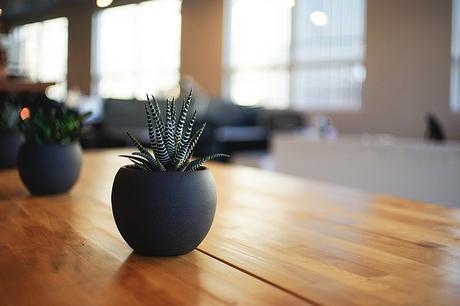The majority of people perceive air pollution to be something only experienced outdoors. However, it has been established that much of the toxic and air polluting substances found outdoors are equally indoors. Be it in the car, at home or the workplace, the air polluting substances are present and can seriously impacts people’s health if the air quality is not kept as clean as recommended.
Aerosol sprays, dusty furniture, scented candles, pet shedding, dust mites and air fresheners are a few examples of indoor air pollutant sources. The good news is that indoor air pollution is easily manageable provided the indoor environment is kept clean and free of the polluting substances. Here are 25+ easy and effective ways to reduce indoor air pollution.

1. Use polishes and hair sprays in well-ventilated areas. The use of polishing substances such as varnish, nail polish, and hair sprays should be done outdoors where there is free flow of air. If these activities have to be done indoors, it has to be well ventilated because they release volatile organic compounds associated with a myriad of health consequences such as lung problems and cancer.
2. Make sure your gas stove is well-ventilated. While cooking at home, it is important to ensure the gas stove is well ventilated to limit the production of carbon monoxide and hydrocarbons produced due to incomplete combustion. These gases are not healthy indoors and pose serious health risks in the long-term.
3. Install exhaust hoods or fans in the kitchen and bathroom to reduce humidity. Humid air in the kitchen and bathroom increases the exposure of the indoor occupants to mold and mildew. Molds carry tiny particles that can enter the body and result in serious illness such as colds, persistent coughs, and even fungal infections. The installation of exhaust hoods and fans in the kitchen and bathroom will help reduce exposure.
4. Ensure that the entire house, office or the car is properly ventilated. Proper ventilation ensures free flow of fresh air indoors, but poor ventilation allows pollutants to accumulate indoors.
5. Avoid smoking indoors. Smoking indoors lead to the accumulation of smoke and toxic substances which seriously impacts indoor air quality. Smoke is associated with numerous cancer causing substances including other toxic elements that are not good for the overall human health. Quitting smoking is the best solution because it ensures improved overall health. Nonetheless, smoking indoors or in the car should be totally disallowed.
6. Before the use of the fireplace, ensure the flue damper is fully open. This simply reduces the accumulation of small dust and smoke particles from the fireplace. It also prevents the release of carbon monoxide often emitted due to incomplete combustion.
7. Get rid of odors; don’t mask them. Most people usually try to avoid indoor odors by masking them with artificial fragrances and air fresheners. It simply worsens the problem because the artificial fragrance or air fresheners contain VOCs and phthalates which can harm your health even more. Instead, find the source of the odors and eliminate, and clean the area with homemade cleaners or with baking soda.
8. Manage critters. Keeping food away and sealing cracks is important because it will keep out pests and insects. This will reduce the need to use pesticides and other critter elimination chemicals. It improves indoor air quality by reducing exposure to toxic substances from the artificially manufactured products to manage critters.
9. Cleaning and dusting should be thorough. Dust can carry bacteria, mold, pet dander, mites, mildew and pollen. Thorough cleaning is highly recommended for improving indoor air quality as it eliminates these substances. Dusting and cleaning should be done using environmentally friendly dusting/cleaning detergents or equipment.
10. Minimize clutter. By minimizing clutter, it is easier to manage the accumulation of dust that carry bacteria, mold, mites and fungi which significantly reduces indoor air pollution from these sources.
11. Remove carpeting if possible. Carpets act as a harbor for small dust particles and pet dander which increases indoor air pollution. The dust particles from carpets are associated with chronic lung problems such as asthma and persistent coughs. Removing the carpeting is a sure way of reducing indoor air pollution.
12. Make homemade cleaners. The majority of the artificially produced home cleaning agents are filled with environmentally unfriendly chemicals that may cause respiratory problems or asthma. Nowadays, there are very simple processes of making homemade cleaners. Sites such as DIY can prove helpful for those who want to take this path in order to reduce indoor air pollution.
13. Remove shoes at the door. Shoes are known to bring more than 50% of dust, disease causing microorganism and outdoor chemicals into our homes. For this reason, the practice of removing shoes at the door is among the simplest ways of reducing indoor air pollution. Frequent mopping and wet dusting with water is highly advisable.
14. Minimize the use of air fresheners. Most people love fragrances, but it should come from pure essential oils which don’t affect indoor air quality. Artificial air fresheners have allergens which circulate in the indoor air and are associated with asthma and allergy attacks. Opting for fragrance free products help reduce indoor air pollution at home.
15. Keep trash covered. Covering trash aids in keeping away pests and insects. It is part of critter management which will reduce the need for the use of pesticides and other artificial critter elimination chemicals. As a result, it will reduce indoor air pollution by reducing toxic substance emission from the artificially manufactured critter management products.
16. Reduce indoor chemical use. Countless household products such as cleaners, pesticides, dyes and laundry detergents are full of chemicals. These chemicals are revealed to be highly concentrated indoors. Therefore, the usage of these products has to be reduced and managed so as to minimize indoor air pollution. Paying a close attention to the products labels can offer an effective management strategy. Still, the best recommendation is switching to natural products that hold less harmful elements.

17. Have car emissions tested regularly. Besides our homes and offices, it’s in the car where people spend considerable indoor time when moving from one area to another. This makes it crucial to maintain the car’s indoor environment. One of the ways to do so is by having the car’s emissions tested regularly to reduce indoor air pollution while in the car.
18. Test your home for radon. Radon is a naturally occurring radioactive element formed by the disintegration of radium. It is found within our homes and exposure can bring about serious health implications. Radon is known to cause development problems in children and lower IQ. Testing for radon and ensuring the home is radon free qualifies as a practical method of reducing indoor air pollution.
19. Fix water leaks. Water leaks contribute to the buildup of moisture and humid air in the indoor environment. As a result, it increases the exposure of the indoor occupants to mold and mildew. Molds harbor tiny particles that can enter the body and result in serious illness such as colds, persistent coughs, and even fungal infections. Fixing water leaks therefore helps in reducing exposure to molds and mildew.
20. Use carbon monoxide detectors. Carbon monoxide can slowly suffocate a person to death. It is produced from incomplete combustion due to improper ventilation of the fireplaces and the gas stove. The use of carbon monoxide detectors help to mitigate its buildup and as such reduces indoor air pollution.
21. Open the windows. Opening the windows is the easiest and simplest way to reduce indoor air pollution. Provided the surrounding outdoor environment is free from effluent, smoke, volatile organic compounds or dust, it offers free circulation of fresh air that reduces indoor air pollution.
22. Wash bedding weekly in hot water. Dust particles, minute toxic elements and pet dander normally accumulate on beddings over time. Because these particles are very small in size, they get suspended in the air and it’s easy to breathe them in even without knowing. Washing the bedding weekly in hot water is the best way of removing them while at the same time improving indoor air quality.
23. Get rid of the scented and commercially made candles. The scented and commercially made candles are the leaders in indoor air pollution. Most of the candles contain paraffin wax and when lit, the wax gives off toluene and benzene, which are carcinogenic substances. On the other hand, the wicks of most scented candles contain lead. The scented candles also contain artificial fragrance. Replacing the scented and commercial made candles with natural beeswax candles is a sure way of reducing indoor air pollution.
24. Use more advanced furnace filters. Furnaces emit millions of small dust and smoke particles. It also releases carbon monoxide if not properly ventilated because of incomplete combustion. Thus, the use of more advanced furnace filters will help reduce indoor air pollution compared to the traditional ones on the account that they are designed to clean the air with up to 99.97% effectiveness.
25. Wisely choose air purifiers. There are numerous air purifiers out there, but selecting a good quality air purifier is the key to improved indoor air quality. The best quality air purifiers are quite and remove about 99% of airborne particles. As much as quality air purifies cost more, it’s worth every penny because it promises better and improved indoor air quality.
26. Implement the use of houseplants to naturally purify indoor air. Plants work wonderfully at getting rid of toxins from the house. Besides, plants are natural and have an esthetic value. On top of that, plants don’t produce noise while purifying the indoor air from toxins. Examples of plants that can help in purification to reduce indoor air pollution include the English ivy, spider plant, Boston fern and peace lily.

